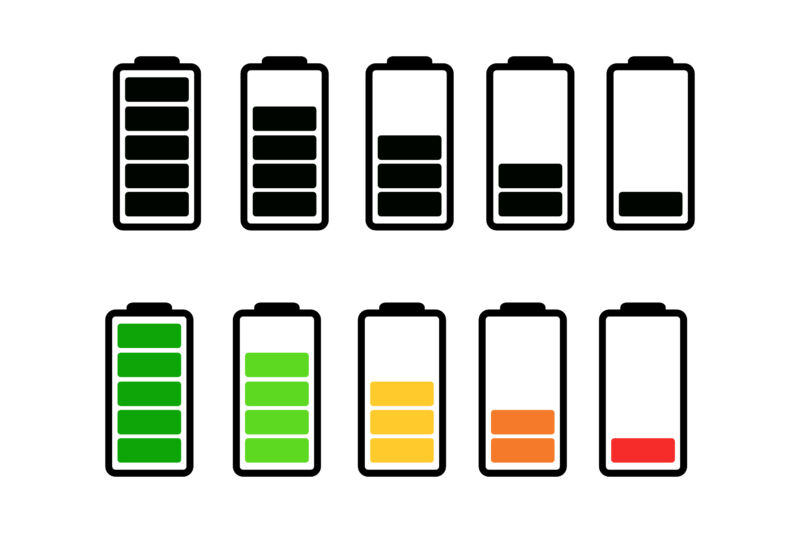
Current lithium batteries are based on intercalation—lithium ions squeeze into spaces within electrode materials such as graphite. As a result, most of the battery's volume and bulk is dedicated to things that don't contribute to carrying charges between the electrodes, which sets a limit on the sorts of energy densities that these technologies can reach.
These limits have led to a lot of research into finding ways to get rid of one these electrode materials. People have tried pairing lithium-metal electrodes with various materials, while other efforts have tried using electrodes where lithium reacts with air to form lithium-oxygen compounds. While these worked by some measures, they tended to have problems that drastically shortened their useful lifetimes.
But a recent paper describes a battery that uses lithium metal at one electrode and lithium air for the second. By some measures, the battery has decent performance out to over 1,000 charge/discharge cycles.
Lots of problems
The problems with lithium metal are pretty well described: It's very difficult to get the lithium to deposit evenly across the surface of the electrode. Over repeated charge/discharge cycles, things that start as subtle irregularities grow into spines called dendrites that the lithium doesn't leave in order to carry charge; eventually, the spines grow until they short the system out. The solution is generally thought to be changes to the electrolytes that the lithium ions travel through when moving between electrodes. At least one company has said it has developed an electrolyte that allows lithium-metal batteries to operate as long as many current technologies.
The problems with lithium-air electrodes are very different and extensive. The support material for the electrode needs to be porous enough to allow air in to meet the lithium and remain that way over many cycles. The reactions it hosts have to avoid reactions with other materials in the atmosphere, like water vapor, which can permanently trap lithium at the electrode. And finally, the electrode has to manage a potentially complicated mix of lithium oxides and peroxides that can form during reactions with oxygen. In many cases, these problems have been so bad that test lithium-air batteries have died after a few dozen cycles.
It's not clear that there's a single solution for these problems. And, unlike the lithium-metal counter-electrode, it's not clear that a different electrolyte would contribute significantly to a solution.
So it's somewhat surprising that the electrolyte in this new work appeared to help manage the reactions with oxygen. And it also helped with keeping a lithium-metal electrode viable. But it wasn't the only thing going on with the new battery design.
Conductors and catalysts
There are essentially two stories that are needed to understand why this battery seems to work. We'll start with the lithium-air electrode, which has two components. The first component is a porous matrix made of a water-repelling material. Embedded in that are nanoparticles of a catalyst that the research group has a long history with, tri-molybdenum phosphide (Mo3P). They started looking at this in 2019, thinking it might be a good option for splitting water to produce hydrogen, since molybdenum is relatively inexpensive. A year later, they considered using it in lithium-air batteries, which also require rearranging bonds among oxygen atoms.
At that point, Mo3P showed exceptional endurance, remaining viable for over 1,200 charge/discharge cycles. But the energy efficiency wasn't all that great. For that, apparently, they needed a better electrolyte.
The electrolyte they worked with is a solid at the temperatures that the batteries would be operating in. It may be difficult to imagine a solid material allowing ions to flow through it, but several solids have been developed with internal channels large enough for ions to pass through. The interior of these channels contains sites that ions can interact with, allowing the ions to make short hops from one stable location to another as they transit. Finally, the density of channels can ensure that newly arriving ions are spread relatively evenly across the surface of an electrode, avoiding issues like dendrite formation on lithium metal.
In this case, it has an added advantage: it keeps the lithium-air electrode exposed to the air. When the researchers tried the same electrode materials in a liquid electrolyte, the chemical reactions that occurred at the lithium-air electrode only went part-way to completion.
The solid portion of the electrolyte is carbon-based but contains a lot of oxygen and silicon atoms linked to the carbon backbone. These polar atoms help provide the lithium ions something they're happy to interact with. The nanoparticles act like a waystation on the trip between the electrodes. They're composed of Li10GeP2S12, a material with both lithium and atoms that like to interact with lithium. This ensures that the electrolyte is filled with lithium ions even when the battery isn't in use, so charges can flow the second the battery becomes active.
reader comments
134